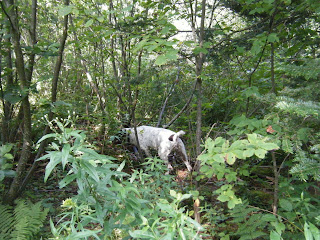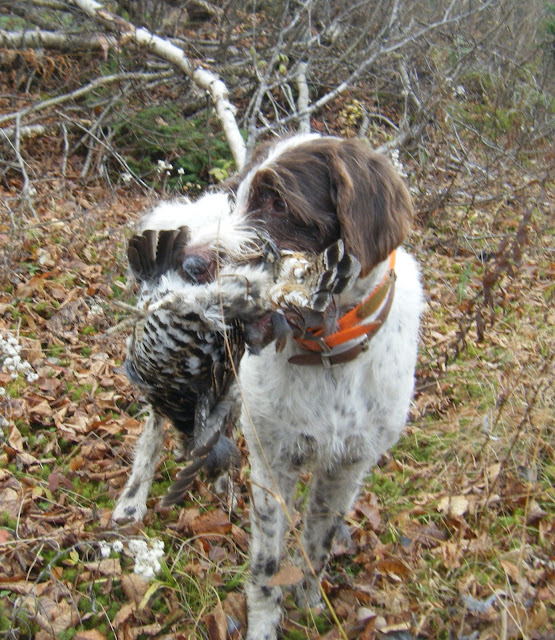 |
| There is a grouse hiding in there. |
In
our neck of the woods most of the grouse hunting stops when the deer hunters
enter the woods the second week of November, but early in December the riflemen
leave the woods to the shotgunners again. The late season can provide of the
loveliest hunting of the year or the snow can be so deep the dogs cannot work. Nothing
is certain.
The
grouse will be in different cover than October, with most of the fruit gone and
snow possibly covering ground covers. Buds and catkins will make up most of
their diet, but the birds also eat a variety of green leafy plants if the snow
isn’t too deep. Hunting the edges of thick softwood stands usually is
productive. |
| Grouse picking at catkins |
Just
like early in the season, often groups are found, frequently up in the boughs
of softwood trees. On sunny days they will come down to feed, foraging for
whatever they can find or to just soak up the sun on a south facing slope. But
when the weather is wet or cold it is easier to retain body heat in the
protection of the softwood trees.
In December it is possible to drive twenty or thirty miles on logging
roads and never see another vehicle. Of course you don’t want to have truck
troubles when you are fifteen or more miles in the woods by yourself. Keep that
in mind and be prepared for a vehicle that might not start.
A
few years back, hunting late in the day in a stand of softwoods long since
harvested by the loggers, I stumbled into a covey of grouse that flushed from
high in the trees. Most flew across the logging road into a cutting that the
previous fall had been waist high weeds with scattered Christmas-tree-sized
spruce and firs. By December the weeds had been flattened by rain, frost, and a
little snow, so it felt like an open park.
Almost
immediately my dog pointed at the base of a fir. On my approach the bird flew
out the back. A minute later the scene repeated, but I went to the left and the
grouse to the right. The scenario repeated a couple more times. If there had
been someone with me the shooting would have been fantastic, but the grouse
were successfully using the trees as shields. Finally, my dog pointed a grouse
that had made the fatal mistake of landing in a raspberry patch surrounded by
flattened weeds. When the bird thundered up above the brambles into the wide
open spaces it was one of the few easy shots one ever gets on grouse.
 |
| Chara during a late season adventure. |
But
the whole time, in the back of my mind, I kept hoping my truck wouldn’t let me
down. It was fourteen miles from there back to the pavement. That weekend I
drove over forty-five miles on logging roads and saw only one vehicle, which happened
to be a logger.
When
the weather gets bitter many who love ruffed grouse hang up their guns and call
it a season to give the birds a break until the next year. Biologists say it
doesn’t make a difference in the overall grouse population, but I still can’t
harass the birds when conditions are tough. The struggle for calories to maintain
body temperature is harsh and one unnecessary flush could be the tipping point
in the delicate balance. I prefer to think that a grouse left alive will have a
big brood in the spring.
This
year the grouse numbers were down. When the deer hunters left the woods I took
the dogs for a few late season hunts, but I’m not sure I would have killed a
grouse. The dogs loved wearing their bells again and hunted hard. I carried my
shotgun, but never raised it to my shoulder. The few birds we found all flushed
from high in softwood trees, with most leaving unseen, and I wished every one
of them well.
The
shotgun went into the safe to wait out spring and clay targets.
Let
us hope the grouse survive and the spring weather is kind to the young broods.
 |
| Tracks. |








































